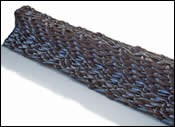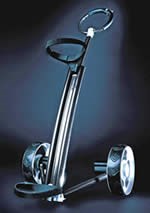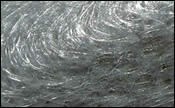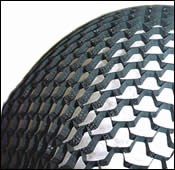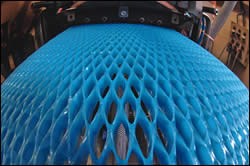Composites--Part II: Winds of Change Stir Materials R&D
Part II of our review of the big composites show in Paris focuses on news in materials and reinforcements. They include lighter, stronger reinforcements for large parts such as wind blades and growing inroads by thermoplastics to speed up production.
Many of the resins and reinforcements introduced at JEC, the big international composites show in Paris this spring, are intended to make molding processes faster and more efficient, especially for large parts such as wind blades. The continuing in flux of thermoplastics reflects that trend, since thermoplastic composites generally permit faster processing than thermosets and result in lower costs. Also prominent at the show were new thermosets for higher temperatures and new reinforcements based on basalt or carbon fibers with weight and other advantages over glass.
Basalt & other fiber news
Basalt fibers, a promising new reinforcement, are becoming more readily available. Kamenny Vek in Russia has started up a new furnace that will add 10 million lb/yr to its current capacity of 2.5 million lb/yr. Basalt is 20% to 30% stronger than E glass and only 5% heavier, so using it can save weight and cost. Basalt producers also claim that glass fibers in composites, unlike basalt, necessitate more frequent maintenance of waste incinerators.
Kamenny Vek came out with a new 600 tex basalt-fiber tape and is working with Ahlstrom Glassfibre Oy in Finland to develop a multifunctional (multi-resin) sizing for basalt fibers. The target is lighter weight reinforcement for very large parts like windmill blades. Ahlstrom says the new sizing will be available on basalt fabrics this year in all standard commercial weaves, for the same price as previous basalt fabrics sized for single resins such as epoxy, vinyl ester, and polyester.
Technobasalt is a two-year-old Ukrainian company that started production of basalt fiber in 2004 at Slavuta, Ukraine, where it makes 1.3 million lb/yr of continuous and chopped basalt fiber.
Basaltex in the Netherlands recently introduced prepregs based on basalt fabrics woven by Dutch sister company Masureel. The fabrics are available in densities of 180 to more than 1200 g/m2 (gsm) and are impregnated with a flame-retardant polyester/urethane and slit into tape. Also new is a hybrid 50/50 glass/basalt lenoweave (gauze-like open weave) fabric for scrim or reinforcement.
Xamax Industries (formerly Sterling Paper) introduced a ba salt-fiber veil to protect fiberglass pultrusions from nicks, burns, and other damage.
JEC saw new carbon-fiber products too. Hollings worth & Vose launched a nickel-coated carbon veil for lightning protection. Composite panels using veil 8000839 re portedly have passed the highest level (Zone 1A) of aircraft lightning protection.
Braiders of 3D carbon-fiber preforms are tackling thicker sections. Biteam AB in Sweden now braids parts with up to 25 x 25 mm cross-section but plans to braid beams three times larger in cross-section and up to 5 meters long when a new machine arrives this year.
Stork Sp Aerospace in the Netherlands displayed a braided carbon-fiber aircraft landing-gear component about 40 mm thick, which has been tested for jet fighters. Unlike the usual forged steel, composites have no corrosion problems and much shorter delivery times. The trick is not to trap air bubbles. Stork, working with the Dutch Aerospace Laboratory, uses advanced ultrasonic 3D “C scans” to spot even very small bubbles.
In more down-to-earth applications for carbon fiber, Mitsubishi Chemical’s Functional Products Div. developed a silane-coated carbon fiber that is being evaluated for vehicle brake discs. Uncoated carbon fiber reportedly isn’t suitable for brakes in wet weather.
Some new products at JEC demonstrated capabilities of making both heavier and lighter carbon-fiber tows. Going up in weight, SGL’s Carbon Group in Germany launched its first 50k carbon-fiber tows, available here from SGL Technic.
At the opposite extreme, suppliers in several countries have been working on ways to spread out heavier tows into thinner, lighter tapes because heavier tows are more efficient to manufacture. Oxeon AB in Sweden claims a breakthrough in being able to make its TeXero unidirectional tapes as light as 40 gsm from carbon-fiber tows of 12k, 24k, or 48k.
Thermoplastics news
One solution to the difficulties of impregnating continuous fibers with thermoplastic resins is to commingle thermoplastic and reinforcing fibers into a moldable fabric. For example, Schappe Techniques in France and molder Thermofusion GmbH in Dieburg, Germany, won JEC’s sports innovation award for an electric-powered golf cart made from a moldable braided preform of 45% by volume nylon 12 fibers and 55% carbon fibers. Thermoplastic prepregs were made by braiding the nylon and carbon fibers and then bladder molding the preform inside a closed tube. The first version of the cart was launched last year using epoxy resin and molding cycle times of over 1 hr. When demand for the product soared, it was converted to thermoplastic with a cycle time of about 10 min.
PPG Industries uses proprietary thermoplastic fibers commingled with glass as a binder for making preforms. Two new PPG rovings, PF 7009B and PF7024A, can be chopped into a preform mold, heated to melt the binder, and then cooled to retain their shape.
In other thermoplastic news, Phoenixx TPC Inc. introduced ultra-thin thermoplastic prepregs weighing only 25 to 30 gsm. And Polystrand Inc. showed a new rigid sandwich made by applying its prepregs of PP and continuous glass onto wood particle board to make lightweight structural panels.
Thermoplastics also showed up in new extruded honeycomb core materials. Nidacell honeycomb from Solvay Group in Belgium is said to be the first honeycomb to be extruded in a one-step process. Solvay is making 260-mm-wide honeycomb sheets on a pilot line. The process extrudes a flat plate, slits it into parallel strips and blows intermittent puffs of air between the strips to open cells and stick the strips together, forming a honeycomb that can be 0.5 to 30 mm thick.
Solvay has tried this process with PVC, PP, PE, and engineering thermoplastics. Cell size and shape can be varied. Solvay recently licensed Renolit Ondex Co. in Chevigny St. Sauveur, France, to produce PVC Nidacell honeycomb for evaluation. It could be filled with urethane foam and/or skinned on both sides to make rigid sandwich panels.
Nidaplast Honeycombs in France, introduced its Nidapan extruded hexagonal PP honeycomb core with glass/PP fiber reinforcement heat-welded onto both sides. It comes in thicknesses of 5 to 150 mm for reinforcing plywood to prevent warping. Nidaplast also launched an economical honeycomb core, called Nestaplast, covered with heat-sealed film.
ESC Extended Structured Composites GmbH of Germany showed its low-cost 3D epoxy-filled core system. It is a flexible network of open hexagons made of PET foam, which are filled with epoxy and then overlaid with fabrics of glass, aramid, and high-strength PE fibers to add stiffness. The result is said to be very drapeable and lightweight, suitable for RTM and vacuum injection of boat hulls and aviation parts.
More new fibers & cores
New fiberglass products include two di rect-draw E-glass fibers (2025 and 2026) introduced by PPG for pultrusion and filament winding.
Johns Manville presented its new MultiStar 267 roving for high-speed SMC molding and a new chopped-glass mat, MultiStar Mat ES33-0-125, for automotive head liners.
Saint-Gobain Vetrotex of France showed its new Uniconform continuous-strand mat, which is available for sampling in the U.S. Uniconform is a flexible, deformable mat in weights of 600 to 1200 gsm. It’s mechanically rather than chemically bonded, so the continuous glass conforms better to mold projections and recesses, the company says. Because it has no synthetic stitching yarns, it’s also good for translucent parts.
Owens Corning showed a new lightweight glass mat called AcoustiMax, designed for greater sound absorption in auto interior parts like head liners, trunk liners, doors, seat backs, and package trays.
Ultracor Inc. showed its UltraFlex honeycomb for the first time. Made of carbon fiber and epoxy, cyanate ester, or phenolic, Ultraflex has a distinctive shape like nested maple leaves, allowing it to conform to bends and curves without collapsing.
A different sort of core material is a very low-density syntactic-foam paste of epoxy filled with hollow glass spheres, used to fill the fan blades in the compressor of Airbus A380 jet engines. Huntsman Advanced Materials won a JEC aerospace innovation award for this Araldite 1641 product, together with co-developers Rolls Royce Engines and the Univ. of Sheffield in the U.K. Fan blades are typically filled with honeycomb for sound damping, but the paste is easier to apply and reportedly gives better sound damping and less vibration.
New resins and more
For styrene-free hand lay-up, Cognis in Germany developed new methacrylate monomers, trade named Bisomer, as styrene replacements in unsaturated polyester. Other chemical companies also are starting to market methacrylate monomer diluents to polyester composites fabricators.
Several companies introduced new epoxies with high-temperature or fire-resistance properties. Huntsman showed a new multi-functional epoxy, MY0600, made with meta-aminophenol, to provide long pot life as well as high modulus in aerospace parts.
Mader in France, in a joint venture with United Paint and Chemical Corp., came up with what’s said to be the first paint for composites that meets an M1F1 classification for extremely low smoke and low flame spread. When it burns, the only emission is water vapor. Up to now, the highest flame classification for composite paints was M1F2 or F3. Mader uses a patented process to graft fire-resistant fillers onto polymer. The product is aimed at automotive.
Ube Industries in Japan recently commercialized (under license from NASA) a polyimide thermoset called PETI-330 with an unusual combination of low viscosity and high-temperature performance. It cures at around 625 F and withstands up to 572 F for RTM molding or carbon-fiber pre pregs for aerospace or engine applications.
Meet benzoxazine
Henkel’s Aerospace Group in Bay Point, Calif., has developed a new toughened thermoset resin based on benzoxazine with low viscosity and long pot life for fabricating aerospace parts. This new resin family boasts better high-temperature and hot/wet performance than epoxy, closer to bismaleimide (BMI) in performance, but much less expensive. Benzoxazine is also room-temperature stable, not needing refrigeration or freezing.
Benzoxazines (a subclass of phenolics) have been known for decades and used in the electronics industry but were not previously marketed for structural aerospace applications. Henkel’s lab name for the resin is Epsilon. It’s available as a one-part, semi-solid resin for structural prepregs and in liquid two-part formulations for RTM. Henkel’s first commercial application is for aerospace tooling.
In other new moldmaking materials, Hexcel Corp. presented a high-heat prepreg called HexTool. It consists of carbon fiber and Hexcel’s HexPly M61 BMI resin. It is said to be very tough and quasi-isotropic, allowing for complex mold shapes. It heats and cools quickly, and is machinable, so molds are easy to repair or modify.
Molds reportedly can be built faster and with better surface finish using new FSP fiber-filled spray putty from Euromere of France. It is based on isophthalic polyester or vinyl ester and its density is 0.6 to 0.8 g/cc, half that of standard putty.
Several companies showed recently developed water-based mold releases. Henkel introduced Frekote 901WB last year for large composite parts. Chem-Trend offers Chemlease Hydrolease for multiple releases and Class A finish. And Axel Plastics showed XtendW-7837D, for producing wind blades with a matte finish.
Wind blade materials
Other new products are also tailored for the burgeoning field of wind-energy blades. As reported in April, Owens Corning came out with WindStrand single-end rovings and knitted fabrics made of a special glass that is up to 35% stronger and 17% stiffer than E-glass. They allow production of bigger blades without the use of more costly carbon fiber.
Gurit in the U.K. (formerly SP Systems) introduced thicker Sprint Triax prepregs (150 to 200 mm) for greater strength in large parts like the outer shell of wind turbines. Sprint Triax is a three-layer prepreg of epoxy film with fabric on two surfaces. The epoxy is a new formulation designed to fill the fabric when heated and compressed under a vacuum bag without requiring an autoclave.
Vacuum bags are also getting bigger to mold large parts like wind blades without seams. Airtech International Inc., Huntington Beach, Calif., introduced Big Blue L-100, a 12-meter-wide, five-layer vacuum bag with adhesive. A 10.5-meter-wide film will soon be offered by Aerovac in the U.K., sister company of Richmond Aircraft Products.
New RTM consumables
Several companies introduced new transport media for resin transfer molding to use between the peel ply and vacuum bag. PGI Industrial (formerly Polymer Group Inc.) introduced Flowmat, a polyester nonwoven with canals that help resin infuse faster. It is distributed in the U.S. by Nida-Core.
Henkel’s new Hysol EA 9895 is a thin polyester wet peel ply, which reportedly needs 30% less peel force than conventional peel plies.
Read Next
For PLASTICS' CEO Seaholm, NPE to Shine Light on Sustainability Successes
With advocacy, communication and sustainability as three main pillars, Seaholm leads a trade association to NPE that ‘is more active today than we have ever been.’
Read MoreBeyond Prototypes: 8 Ways the Plastics Industry Is Using 3D Printing
Plastics processors are finding applications for 3D printing around the plant and across the supply chain. Here are 8 examples to look for at NPE2024.
Read More



